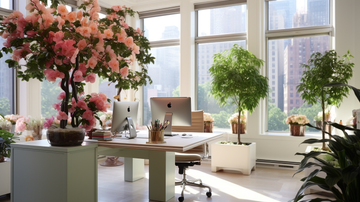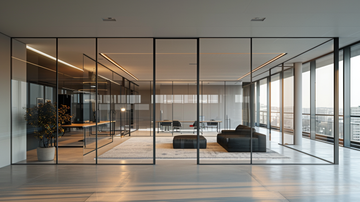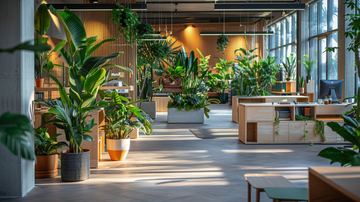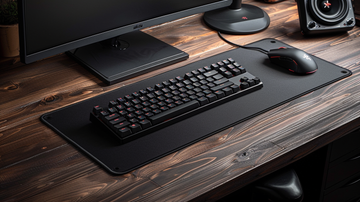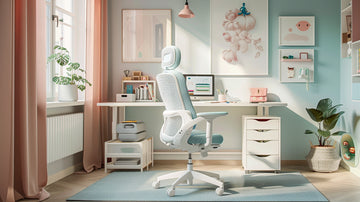Introduction
Having plants in an office environment can provide many benefits for employees and employers alike. Studies have shown that incorporating greenery into office spaces can boost productivity, improve concentration, reduce stress, increase creativity, and elevate moods. Plants can also improve indoor air quality by absorbing toxins and releasing oxygen. With so many advantages, it's no wonder that more and more companies are embracing the use of plants as part of their office design and decor.
This article will explore how to effectively decorate your office with plants to maximize the benefits. We'll cover choosing the right plants, determining lighting needs, selecting planters, placement ideas, incorporating greenery into walls, and more. Properly caring for and maintaining office plants will also be discussed. By the end, you'll have plenty of tips and inspiration for bringing nature's beauty into your workplace.
Choosing the Right Plants
When selecting plants for your office, it's important to choose varieties that require minimal care and maintenance. Some of the best low maintenance office plants include pothos, philodendrons, ZZ plants, snake plants, and succulents. These plants don't need frequent watering or pruning and can tolerate low light conditions (source).
In addition to being low maintenance, many popular office plants are excellent at purifying indoor air. Some top air purifying options are peace lilies, English ivy, Boston ferns, aloe vera, and spider plants. These plants naturally remove toxins like formaldehyde, benzene, and carbon monoxide from the air through their leaves and root systems (source).
When selecting office plants, it's wise to choose a combination of low maintenance and air purifying varieties. This ensures you have greenery that thrives with minimal care while also improving air quality for employees.
Determining Lighting Needs
When choosing plants for an office, it's important to consider the lighting conditions. Most offices have fluorescent overhead lighting which typically does not provide enough light for plants to thrive. South facing windows provide brighter light which certain plants prefer.
According to the University of Minnesota Extension, plants require different distances from light sources depending on the type of plant [1]. For example, foliage houseplants need 12-24 inches of light while flowering plants need at least 12-16 hours of light per day.
If your office lacks sufficient natural light, you may need to supplement with artificial lighting. LED grow lights are an energy efficient option for providing full spectrum light that mimics sunlight. According to Skh.com, high light plants like succulents and cacti require at least 6 hours under grow lights per day [2]. Grow lights on timers can automate this process.
When determining lighting for office plants, consider the direction of windows, proximity to light sources, and supplementing with artificial light as needed. Proper lighting will keep plants healthy and thriving.
Selecting Planters and Pots
When selecting planters and pots for office plants, there are a few key factors to consider:
Material - Planters come in a variety of materials like ceramic, plastic, metal, and wood. Ceramic and terra cotta provide good air circulation but can crack over time. Plastic is affordable and lightweight but doesn't have great aesthetics. Metal like copper or zinc can add an elegant touch. Wood brings natural warmth.
Drainage - Proper drainage is crucial for healthy plants. Look for pots with drainage holes at the bottom to prevent roots from sitting in water. You can add pebbles or stones in the bottom of the pot to improve drainage.
Matching decor - Choose planters that fit your office's decor and style. For modern spaces, sleek metal or geometric-shaped pots work well. For traditional spaces, classic terra cotta or urn-shaped pots complement the look. Make sure colors and textures coordinate.
Some great options for office plants are the Self Watering planters from Amazon which regulate moisture. Eplanters has a wide selection of indoor pots and planters with chic contemporary designs.
Caring for Office Plants
Properly caring for office plants is crucial to keeping them healthy and thriving. Here are some tips on watering, fertilizing, and pruning office plants:
Watering is one of the most important aspects of caring for office plants. The frequency of watering depends on factors like the type of plant, pot size, sunlight exposure, and climate. As a general rule, most office plants need watering once a week. The best way to water plants is over a sink, letting the water run right through the plant and into the sink. Alternatively, you can water a plant in a saucer, allowing it to soak up water from the bottom (The Ultimate Guide To Office Plants: Low Maintenance Plants, https://www.ambius.com/resources/blog/plant-profile/the-ultimate-guide-to-office-plants).
Fertilizing office plants provides nutrients and helps them grow stronger. Use a balanced liquid fertilizer diluted to half strength every 2-4 weeks during the growing season (spring through fall). Reduce fertilizing in winter. Always follow label directions carefully.
Pruning and trimming maintains the shape, size, and health of office plants. Remove any dead, yellowed, or diseased leaves regularly. Cut back overgrown plants to keep them compact for the office environment. Specific plants like ficus trees need more extensive pruning to maintain their shape (A Quick Guide to Office Plant Maintenance, https://thereceptionist.com/blog/a-quick-guide-to-office-plants/).
Where to Place Plants in an Office
When deciding where to place plants in your office, there are a few key areas to focus on such as desks, windowsills, and shelves.
Desks are a great place for small plants that won't take up too much space. Succulents, air plants, and small pots of herbs or flowers can liven up an office desk without getting in the way. Be sure not to place plants somewhere they could get knocked over easily. Many people put small plants near computer monitors or next to desk organizers.
Windowsills are prime real estate for office plants. The natural light streaming in from the windows allows many plants to thrive. Spider plants, pothos, and dracaena are especially suitable for windowsills as they don't require direct sunlight. Place plants in front of the window or off to the side if the sunlight is very intense during certain times of day.
Shelves, whether standalone or mounted on the wall, provide ample room to display larger office plants. Shelves near windows are great for plants that enjoy bright, indirect light. Be sure to use proper pots with drip trays to avoid water damage on the shelves. Philodendrons, ferns, and peperomias grow beautifully on office shelves.
No matter where you decide to place plants, be conscious of not blocking walkways and exits. And don't place plants somewhere that people may trip on them and get injured. With some strategic planning, it's easy to integrate office plants in many spaces for a vibrant, inviting environment.
Adding Greenery to Walls
Incorporating plants into your office design doesn't just have to be at desk level. Greenery on walls can bring vibrancy and life to any office space. Here are some options for adding plants and greenery to your office walls:
Hanging plants - Hanging plants are a great way to add greenery at different heights across your office walls. Choose trailing or cascading plants like philodendrons, pothos, spider plants and ferns that will drape beautifully in a hanging planter. Go for lightweight plastic hangers that can hook right over a wall nail.
Wall mounted planters - Wall mounted planters allow you to arrange plants neatly on the wall, while avoiding taking up desk and floor space. Opt for hardy succulents or air plants in these planters. You can find many stylish options for wall mounted planters made of wood, metal, plastic or other materials from retailers like Amazon (https://www.amazon.com/wall-planters/s?k=wall+planters), Wayfair (https://www.wayfair.com/outdoor/sb2/indoor-wall-mounted-planters-c1825332-a2910~6716-a2911~20557.html) and Squarely (https://www.squarely-copenhagen.com/collections/wall).
Living walls - Living walls involve covering a large section of a wall with greenery, creating a living plant "tapestry". This is achieved by securing planters to the wall or using a special vertical hydroponic system. Succulents like sedum are ideal for living walls. Living walls require professional installation but make a major visual impact in an office.
Incorporating Plants into Office Design
When selecting office plants, it's important to consider how they will complement your existing office decor. Plants can help enhance the feng shui of a space when thoughtfully incorporated.
For example, placing leafy plants like philodendrons or pothos near the entrance of an office can promote positive chi and welcome people in. Succulents and cacti work well on desks as they don't require frequent watering. Tall plants like bamboo palms or ficus trees in corners can help divide open spaces. Hanging plants near windows add warmth and vibrancy.
Consider the shapes, colors, and sizes of plants and pots to find options that align with your office's aesthetic. Peace lilies, with their graceful white blooms, often complement minimalist designs. Ferns and ivy in natural woven baskets can enhance rustic or boho spaces. For modern offices, sleek pots and architectural plants like ZZ plants or snake plants tend to work well.
When placing plants, allow them to grow and trail naturally rather than tightly pruning them. This promotes prosperity and abundance, according to feng shui principles. Locating plants near the wealth corner of an office (the back left corner from the entrance) can also attract positive energy and success (source).
With some thought about design harmony and energetic flow, plants can make offices feel more welcoming, fresh, and put employees in a positive mindset.
Choosing Pet-Friendly Plants
When selecting plants for an office environment, it's important to consider whether pets may be present. Certain plants can be toxic to cats and dogs if ingested, so opting for pet-friendly varieties is crucial.
According to Architectural Digest, Chinese Money Plants, Hoya varieties, Spider Plants, and Rattlesnake Plants are non-toxic options safe for pets [1]. The Spruce also recommends Boston Ferns, African Violets, Baby's Tears, and Chinese Evergreens as pet-safe choices [2].
When in doubt, reference a reputable source like Lively Root that details pet-friendly plants specifically. Their list includes Money Trees, Chinese Money Plants, Areca Palms, and Peacock Plants as non-toxic varieties [3].
Doing thorough research is key to ensuring any plants in your office will be safe for visiting pets. Opt for the pet-friendly varieties mentioned above for a worry-free indoor garden.
Air Purifying Plants
Certain plants are especially effective at removing harmful pollutants from indoor air. A NASA study identified the top air purifying plants for removing chemicals like benzene, formaldehyde, and trichloroethylene from the air. The top performers were areca palm, lady palm, bamboo palm, rubber plant, dracaena, English ivy, dwarf date palm, ficus, Boston fern, and peace lily.
These plants remove pollutants through a process called phytoremediation, where the plant absorbs the pollutant through their leaves and roots. The pollutants are then converted into nutrients for the plant or transpired through the leaves.
According to NASA's research, placing 15-18 good-sized houseplants in an 1800 square foot home can effectively purify indoor air. The more plants, the better the air purification. Grouping plants together also boosts their effectiveness.
When selecting air purifying plants, choose varieties that are low maintenance and suited to the light conditions in your office. Some top choices are snake plant, spider plant, peace lily, aloe vera, English ivy, and philodendrons.
Mood Boosting Plants
Adding plants with uplifting greens and colors to your office can have a positive effect on mood and mental health. Studies have shown that being around plants can lower stress and anxiety levels, while improving concentration and productivity (https://bloomscape.com/green-living/office-plants-lower-stress-improve-concentration/). The colors green and blue in particular are associated with feelings of relaxation.
Some great mood boosting plants to consider for your office include:
- Snake plant - Features upright sword-like leaves in shades of green with yellow or white edges. Known to purify air and reduce stress (https://www.shrubhub.com/blog/10-of-the-best-plants-for-mental-health-office-stress-relief.php).
- Spider plant - Has long cascading green and white striped leaves. Helps filter air pollutants (https://www.passporthealthusa.com/employer-solutions/blog/2019-12-how-can-an-office-plant-help-physical-and-mental-health/).
- English ivy - Trails vines with green heart-shaped leaves. Can reduce anxiety and improve focus.
- Pothos - Features green heart-shaped leaves with yellow or white markings. Known as an easy-to-grow air purifier.
Position these plants in areas where you want to promote a positive outlook. Having a view of calming greens while working can lift your mood.
Plants for Different Office Spaces
The type of plants you choose for your office will depend on the different spaces and how much natural light they receive. Here are some recommendations for plants in various office settings:
Cubicles
Cubicles often have low light, so it's best to choose low light plants. Some top recommendations include:
- ZZ plant - With glossy leaves and an easy-going nature, the ZZ plant thrives in low light cubicles (https://www.greencleandesigns.com/best-cubicle-plants/).
- Pothos - Known for its vining leaves and ability to purify air, pothos is a cubicle favorite as it tolerates neglect (https://nymag.com/strategist/article/best-cubicle-plants.html).
- Chinese evergreen - The variegated leaves of the Chinese evergreen add visual interest to cubicles, and it does well in low light.
Private Offices
Private offices often have more space and light. Some great options include:
- Snake plant - With tall, rigid leaves, the snake plant makes a striking statement in offices. It tolerates low light but also does well in bright offices near windows.
- Peace lily - The graceful white blooms of the peace lily brighten up offices. It adapts well to different lighting conditions.
- Spider plant - Known for its trailing shoots with baby spiderettes, the spider plant filters toxins from the air. It thrives in both low and bright light offices.
Common Areas
Larger plants can make a bold statement in common areas and lobbies. Consider:
- Fiddle leaf fig - With its large, fiddle-shaped leaves, this tree makes a dramatic focal point. It needs ample bright, natural light.
- Rubber plant - The large, waxy leaves of the rubber plant add intrigue to common areas. It tolerates lower light but thrives in bright spaces.
- Bamboo palm - This tall palm tree makes a tropical statement. It adapts well to different lighting but prefers bright, indirect light.
Scheduling Office Plant Care
Proper scheduling is crucial for keeping office plants healthy. Assigning watering and pruning duties to staff ensures plants get the care they need. Consider creating a watering schedule that outlines when each plant needs watering based on factors like sunlight exposure, plant type, pot size, and growing season. For example, plants in sunny spots may need watering twice a week in summer but only once a week in winter.
Succulents and cacti may only need watering every 2-3 weeks whereas tropical plants require more frequent watering. Larger pots also retain more moisture. To avoid confusion, create a spreadsheet, calendar or use apps to schedule each plant's watering duty. Assign prunings based on plant growth patterns - typically in spring and summer. Scheduling duties keeps plants from being neglected but avoid overwatering with rigid schedules. Check soil moisture before watering and adjust as needed.
Rotating duties among green-thumbed staff prevents burnout. Consider monthly rotations. Proper scheduling sets up a care system ensuring office plants get the consistent care they need to stay healthy and boost office environments.
Purchasing Office Plants
When purchasing plants for your office, you have a few options to consider:
Local Nurseries - Visiting your local plant nursery or garden center allows you to see plants in person before purchasing. This can help ensure you select healthy plants in the size and type you want. Local nurseries may offer more unique or rare varieties not found at big box stores. Prices and selection will vary by location.
Online Stores - Ordering plants online opens up more options without being limited by local inventory. Reputable online plant stores like Lively Root and House Plant Shop offer wide selections with ordering and fast shipping across the U.S. Buying online means you can't see the exact plant first, but photos and descriptions help. Order early to avoid weather delays.
Budget - Office plants can range from $5 to $50+ depending on size and type. Set a realistic budget based on how many plants you need and can properly care for. Starting small with a few key statement plants can make a big impact without breaking the bank. Prioritize plants that fit your office lighting and climate.
Conclusion
Decorating your office with plants can greatly enhance your workspace. When choosing office plants, be sure to consider factors like lighting, planters, placement, and care. The right plants can boost mood, increase focus, and purify the air. Some key takeaways are:
- Determine the lighting you have available, such as bright indirect light or low light, and choose plants suited for those conditions.
- Select planters that fit your office décor and allow drainage. Cachepots can provide a decorative outer planter.
- Place plants in areas where they can get adequate light and will not block walkways.
- Create a watering schedule based on each plant's needs to keep them thriving.
- Incorporate different shapes, sizes, and varieties of greenery to add visual interest.
- Consider air purifying and mood boosting plants for additional benefits.
With the right selection and care of office plants, you can bring natural beauty and a vibrant atmosphere to your workspace.

